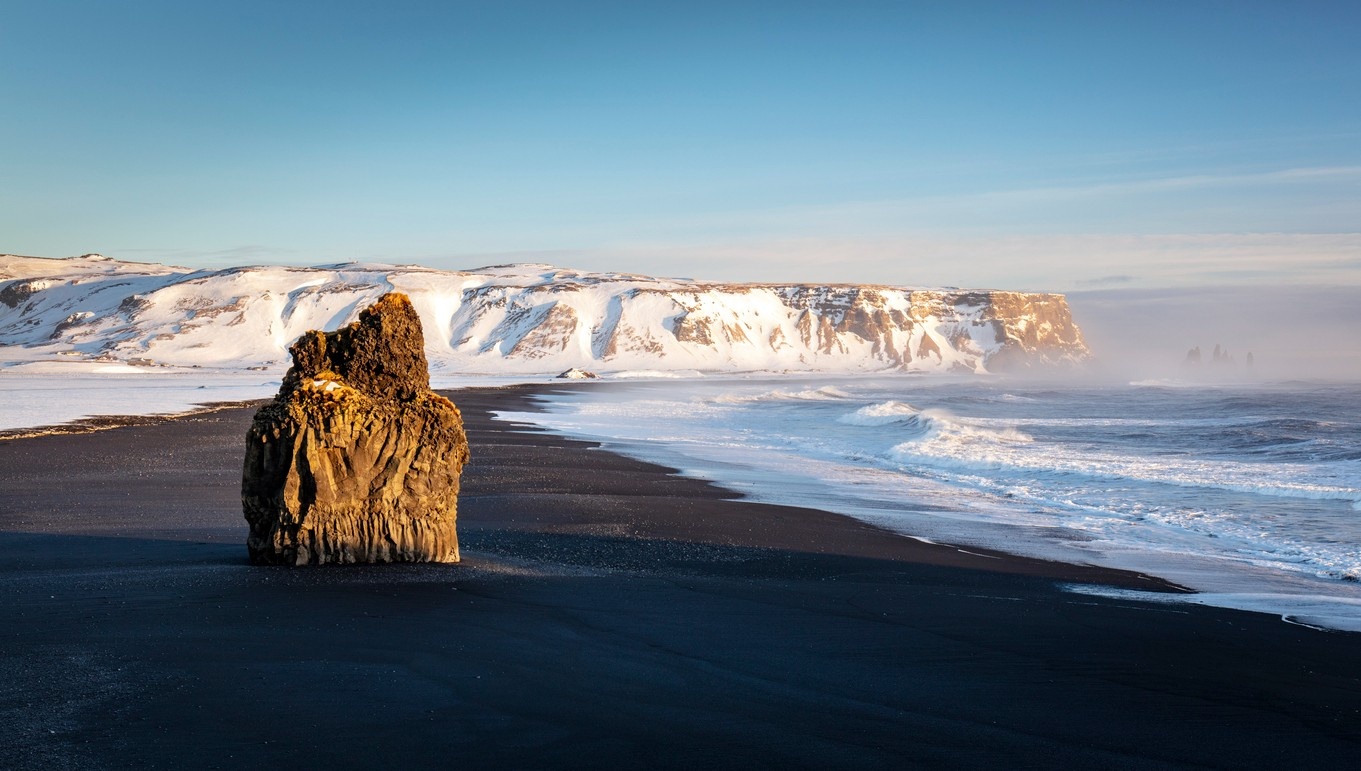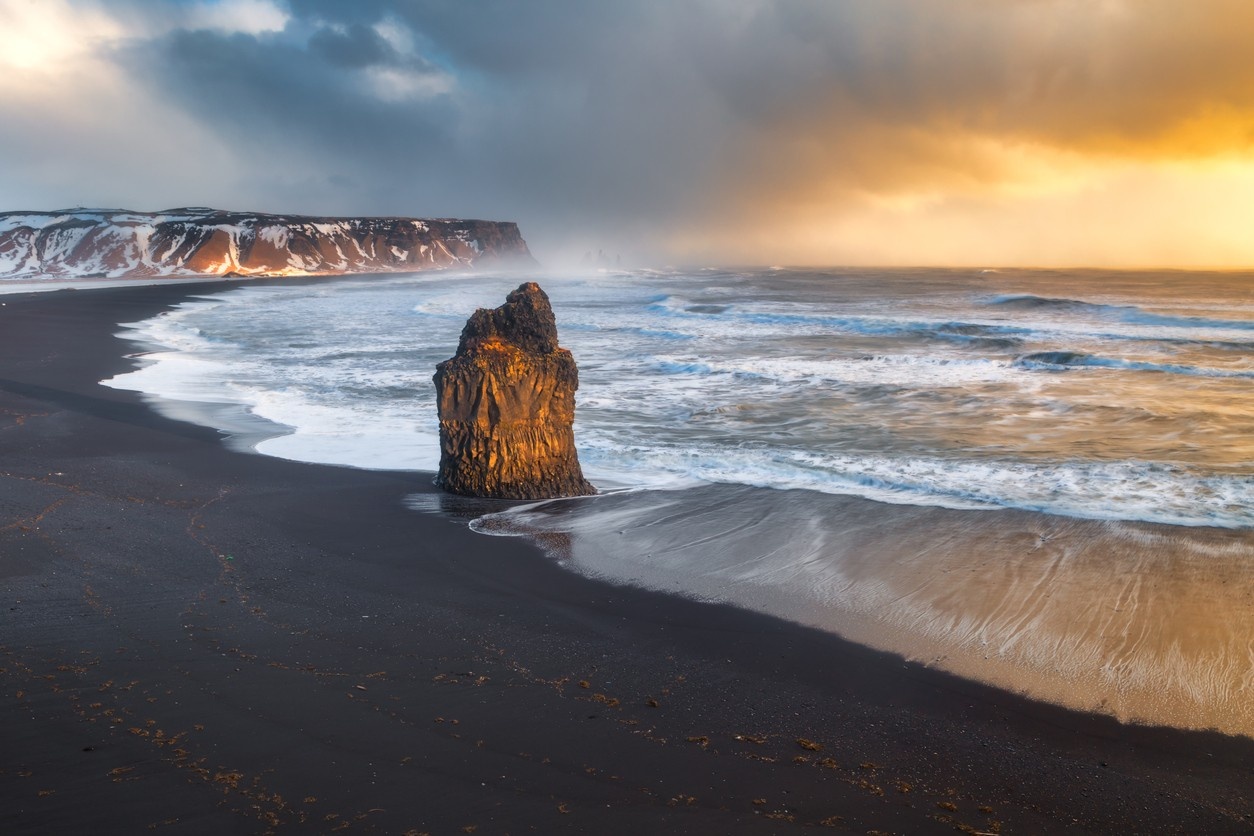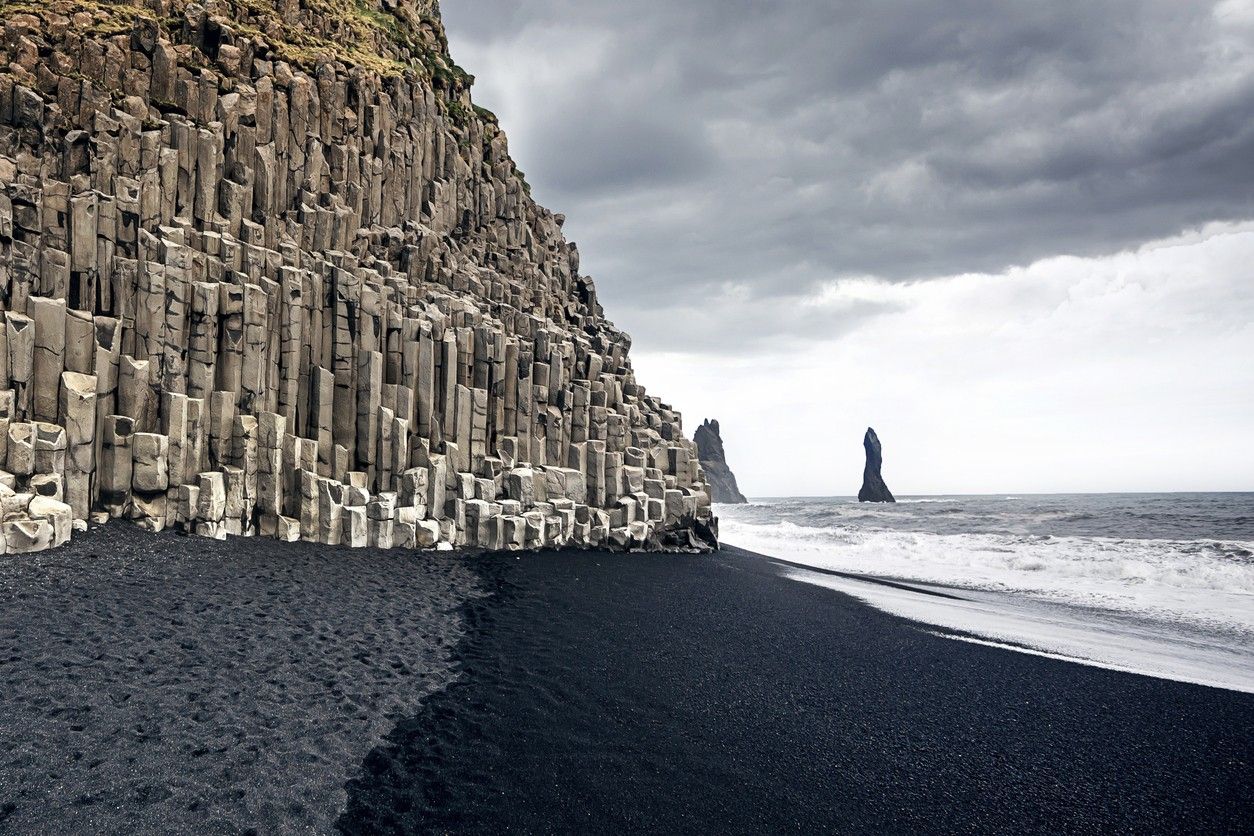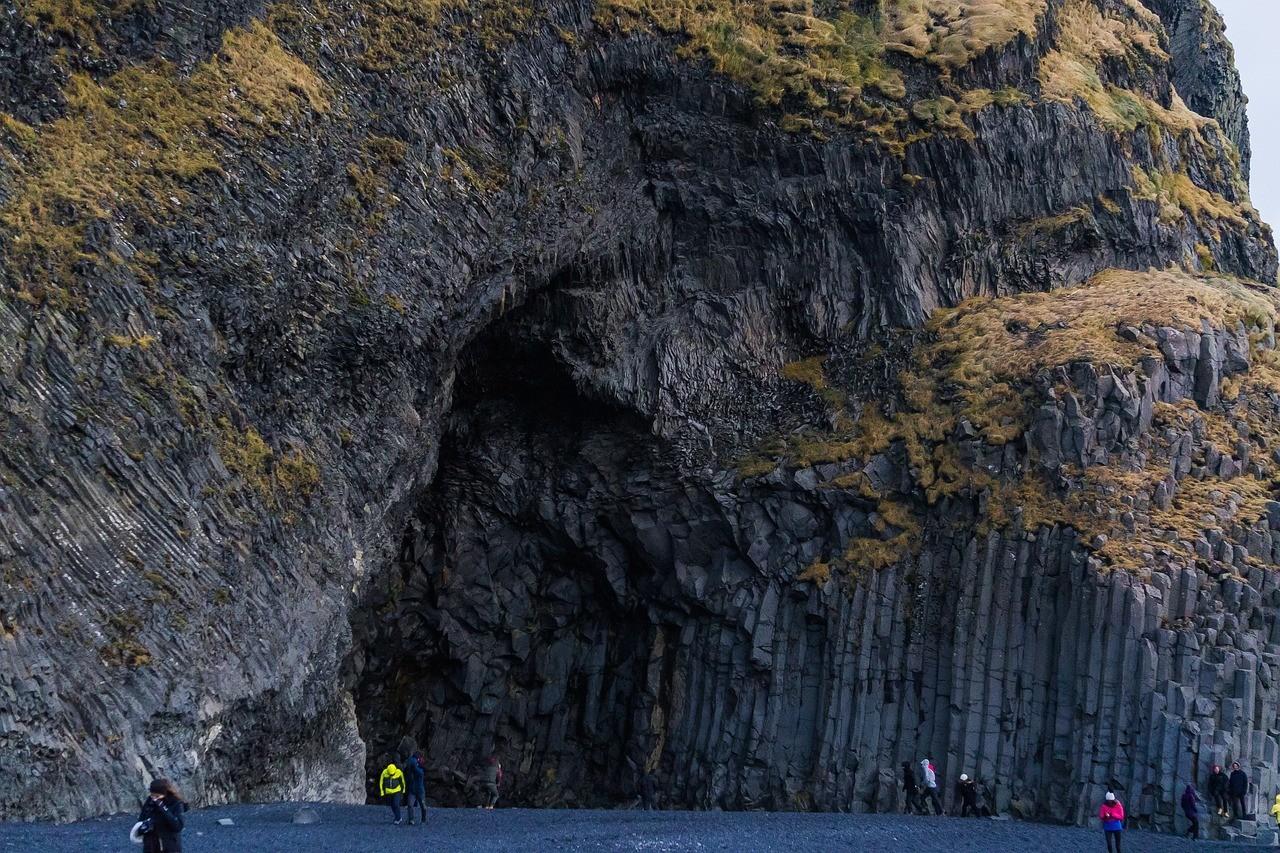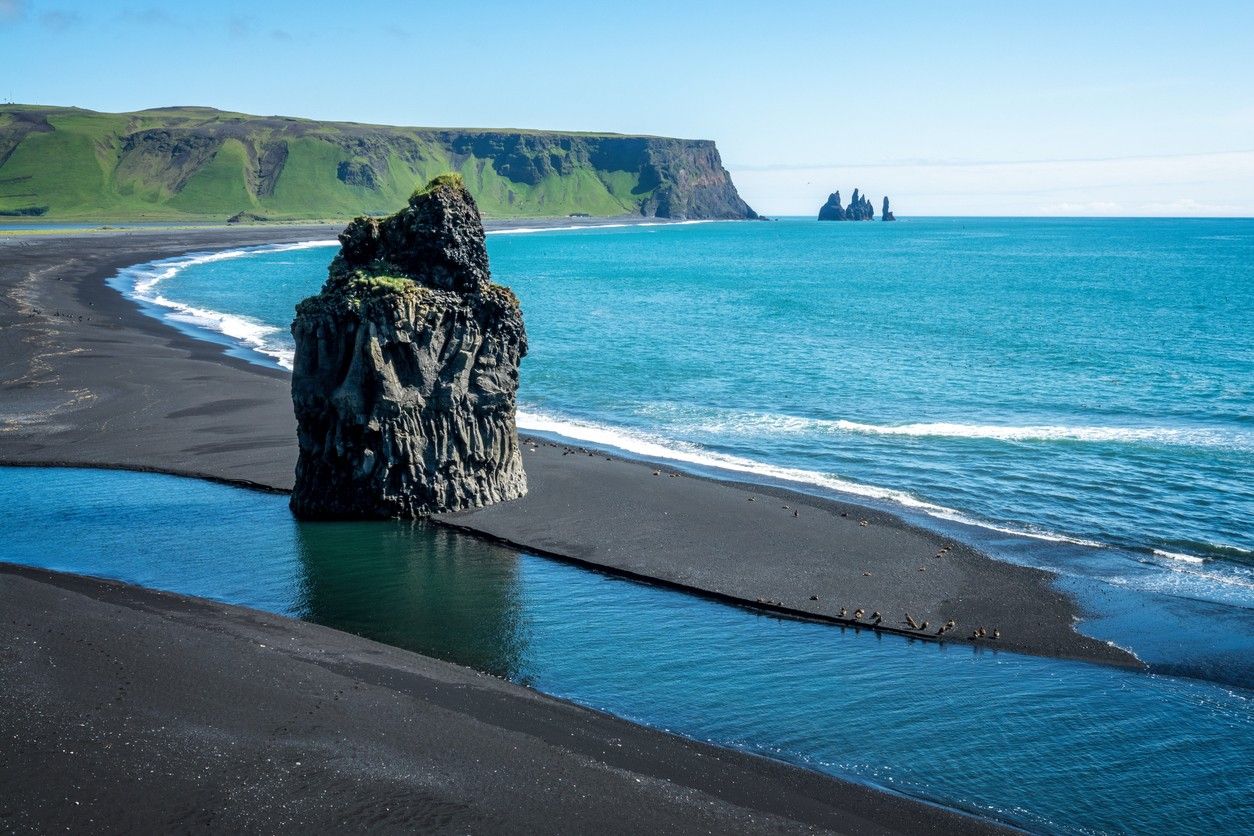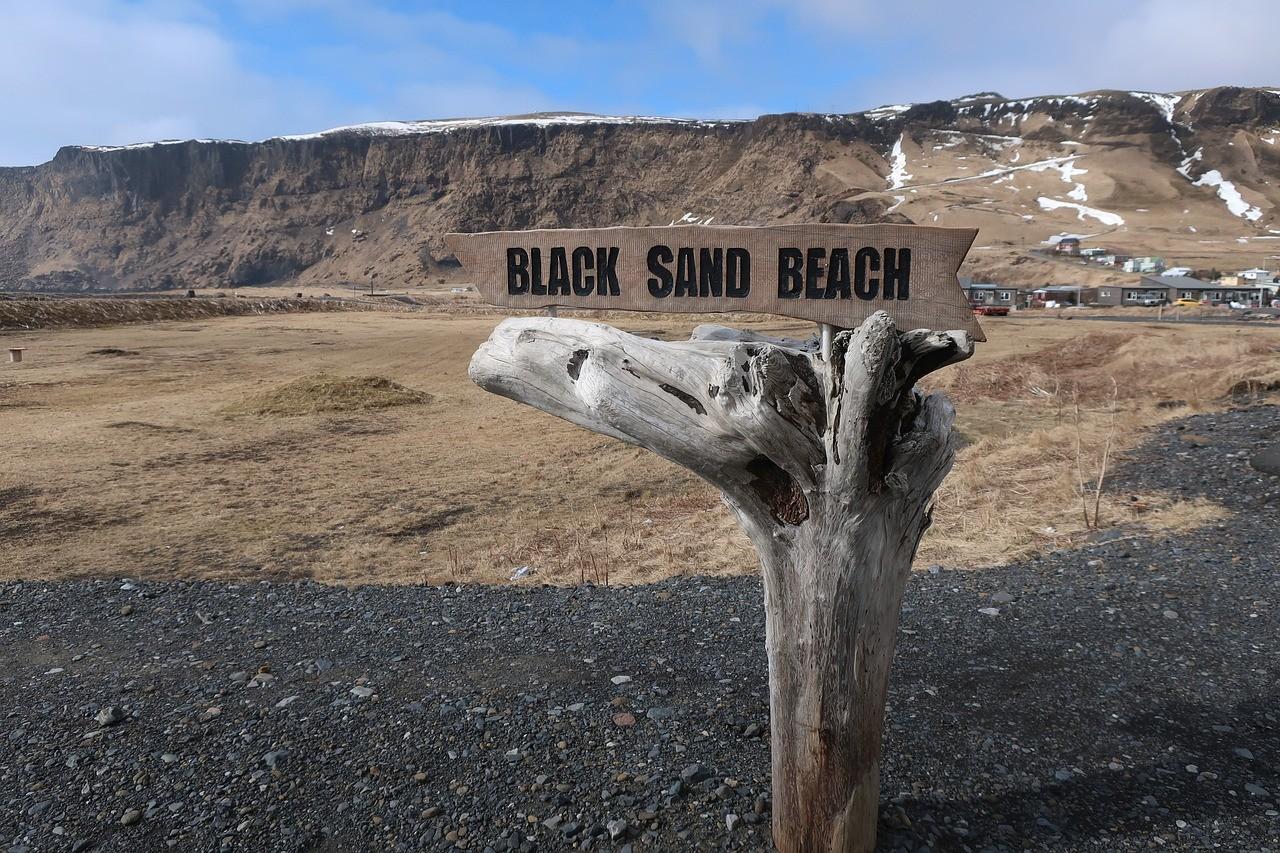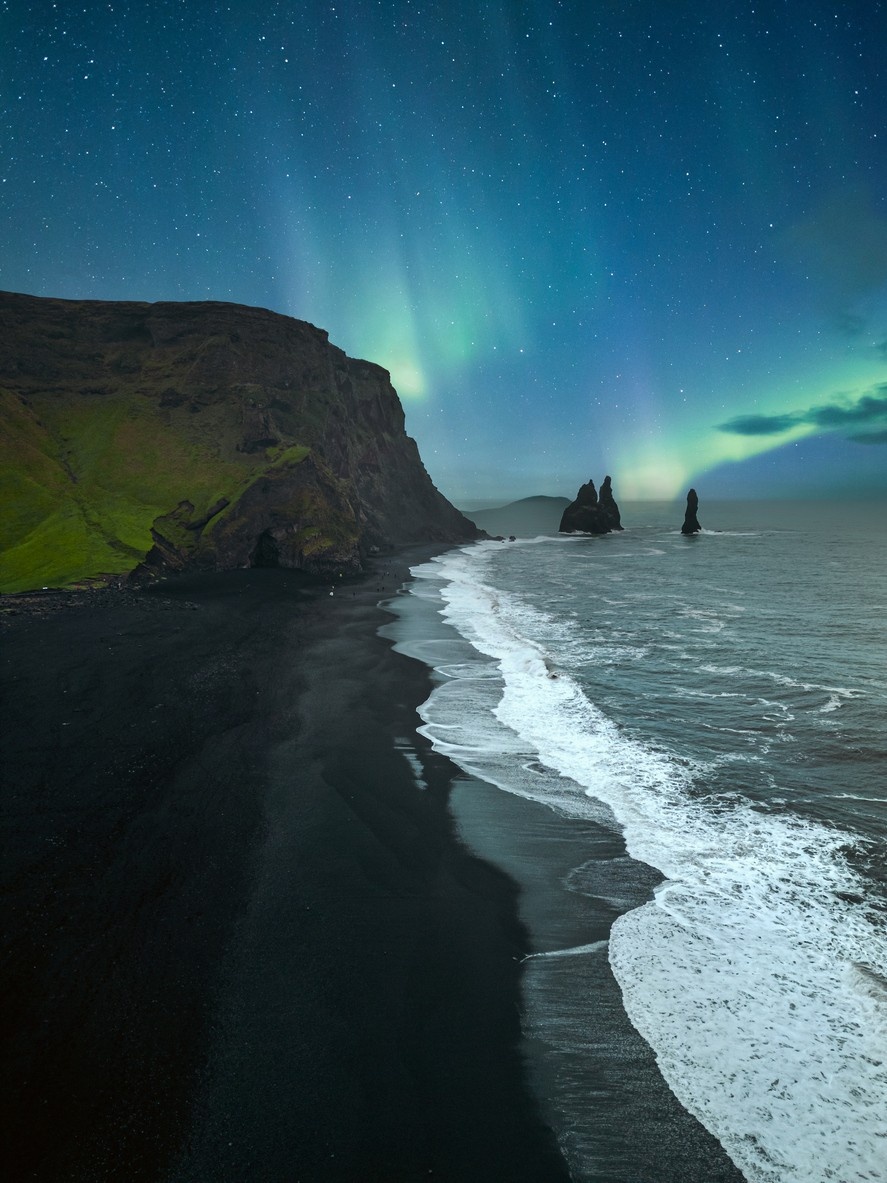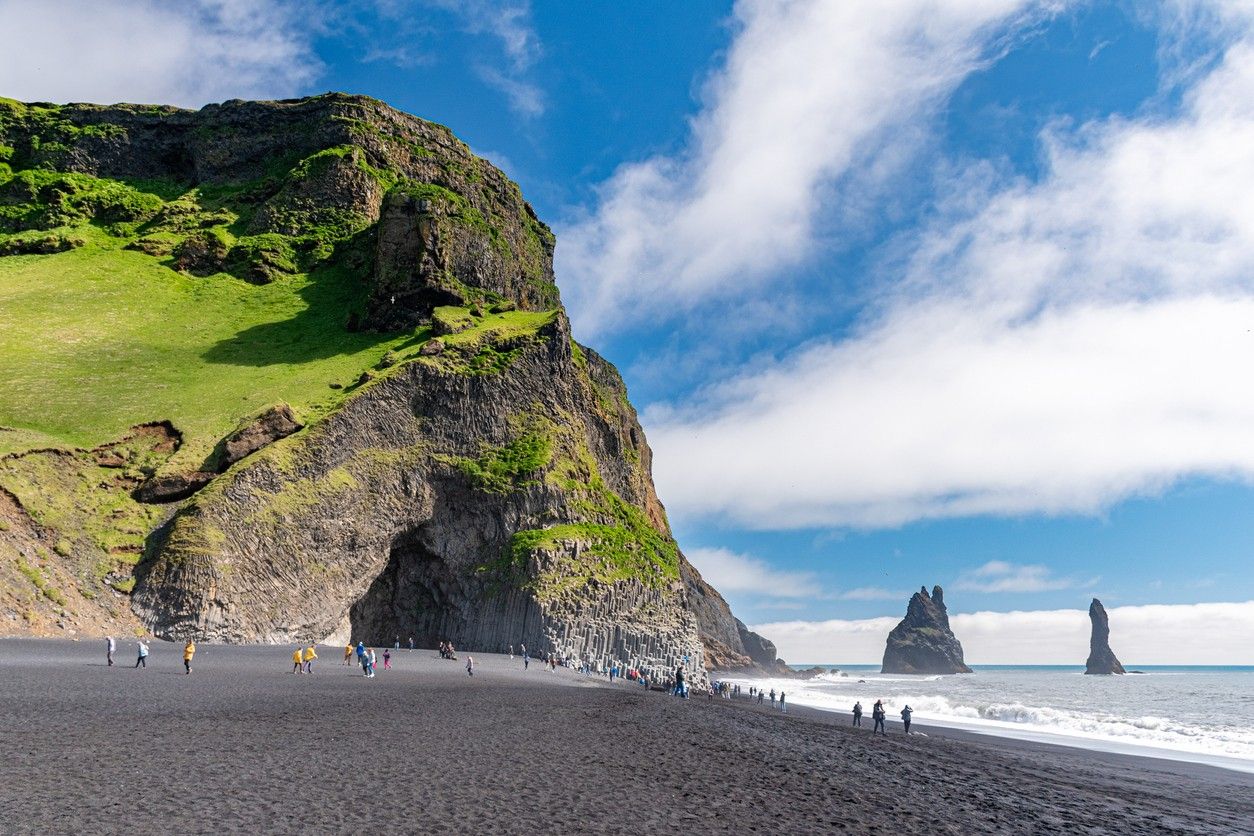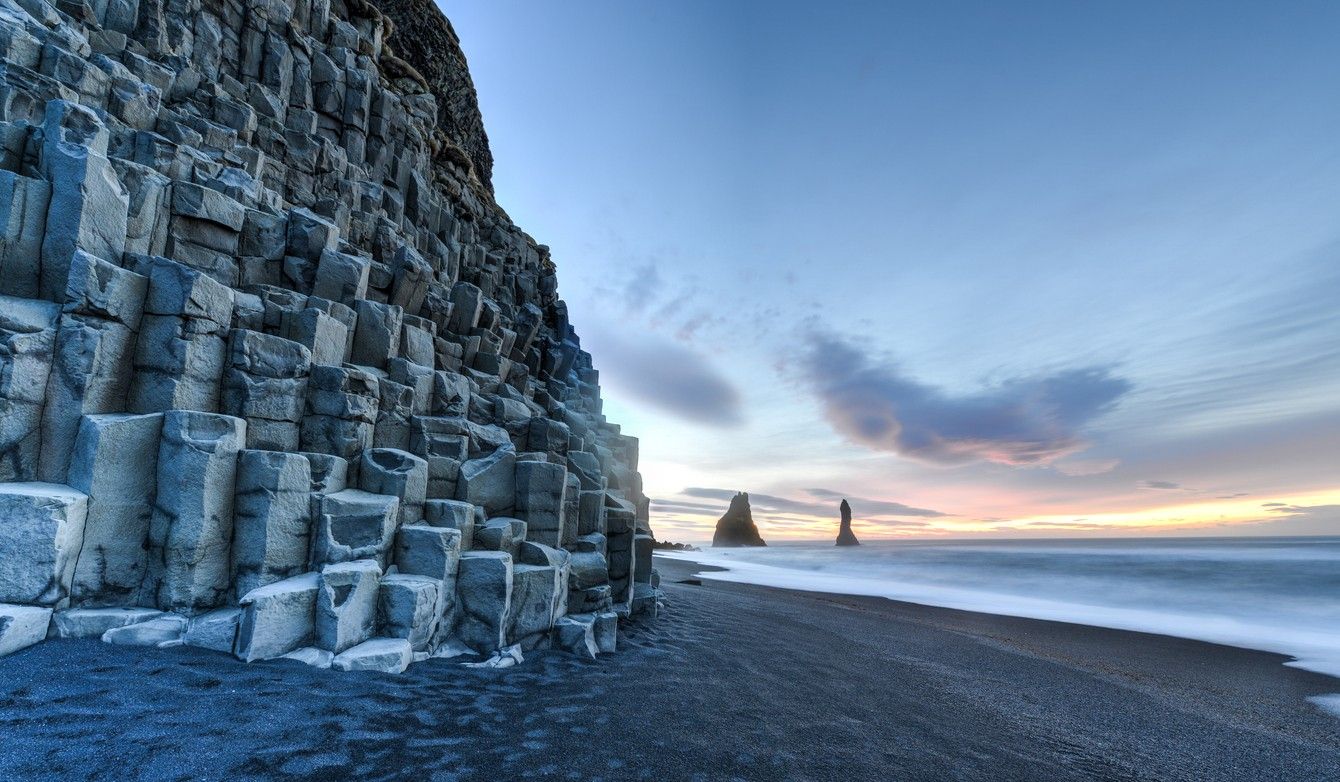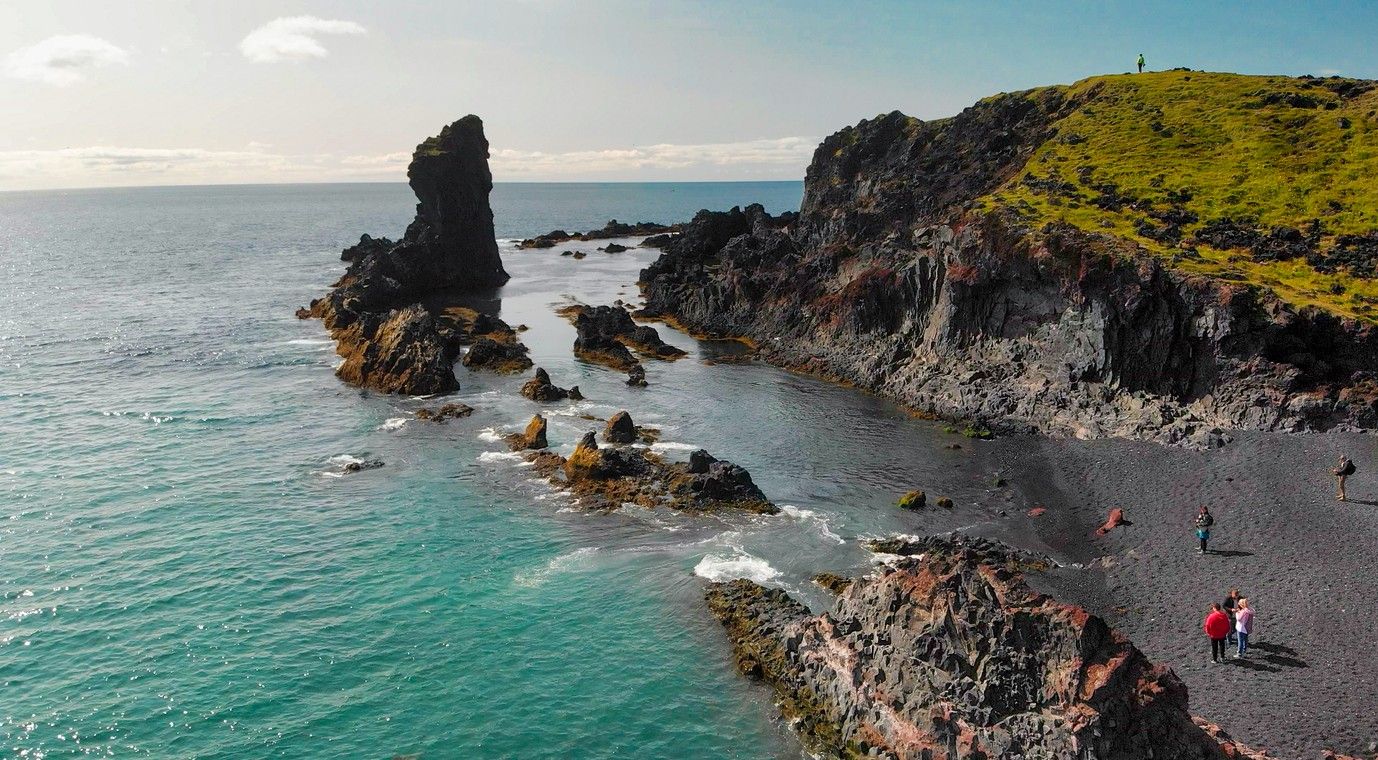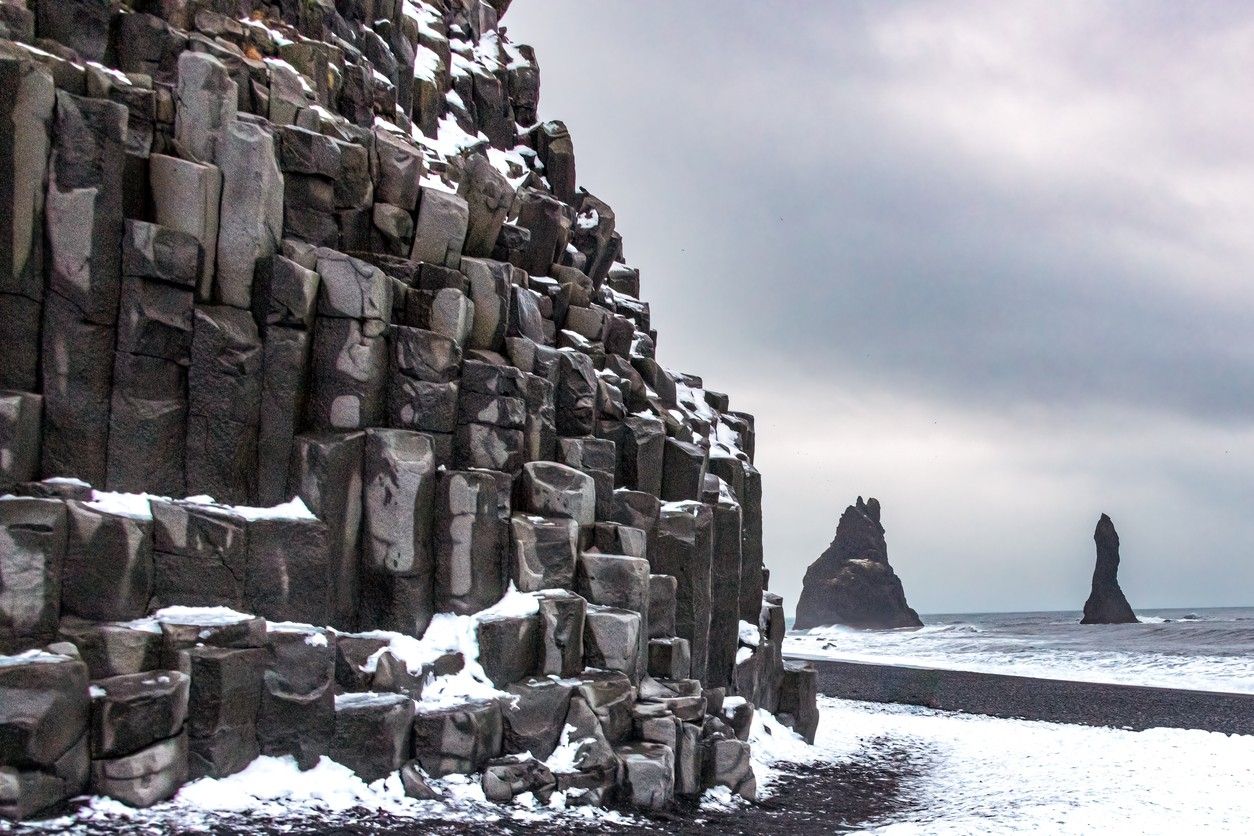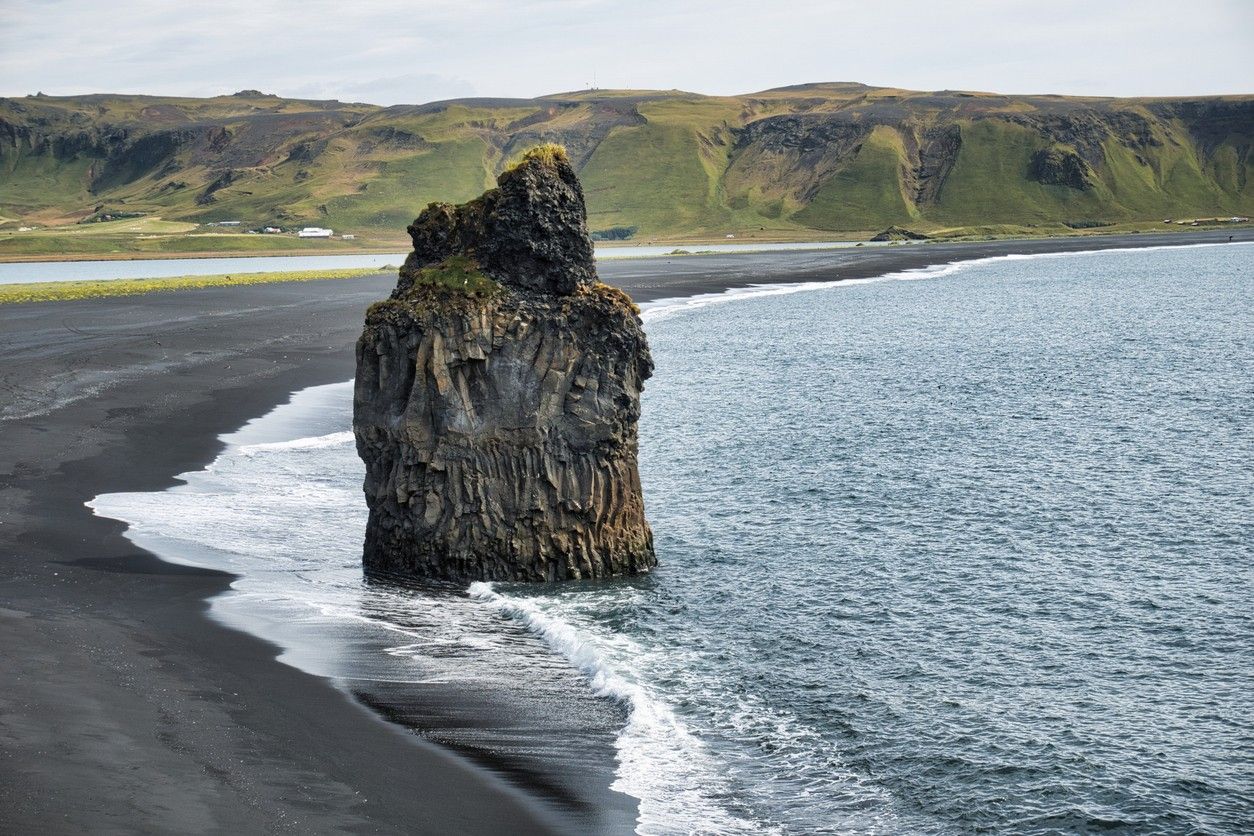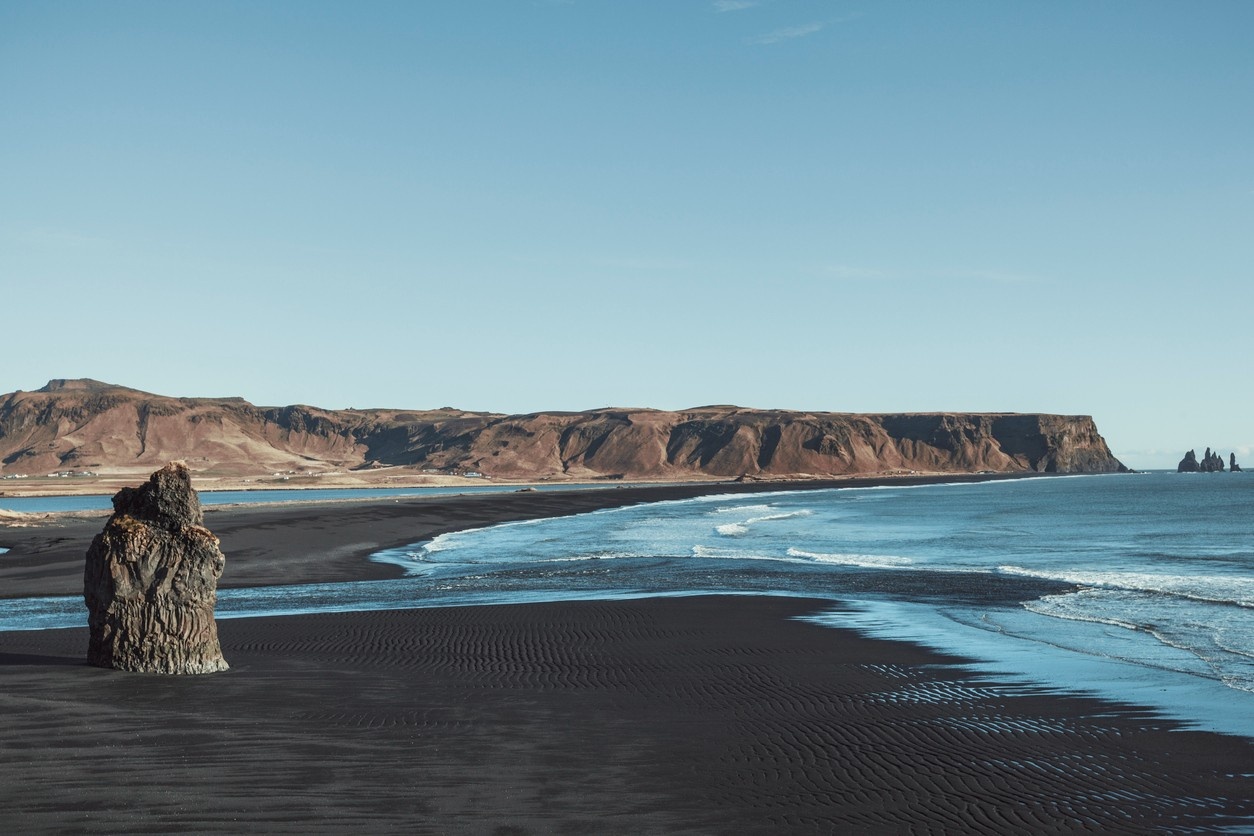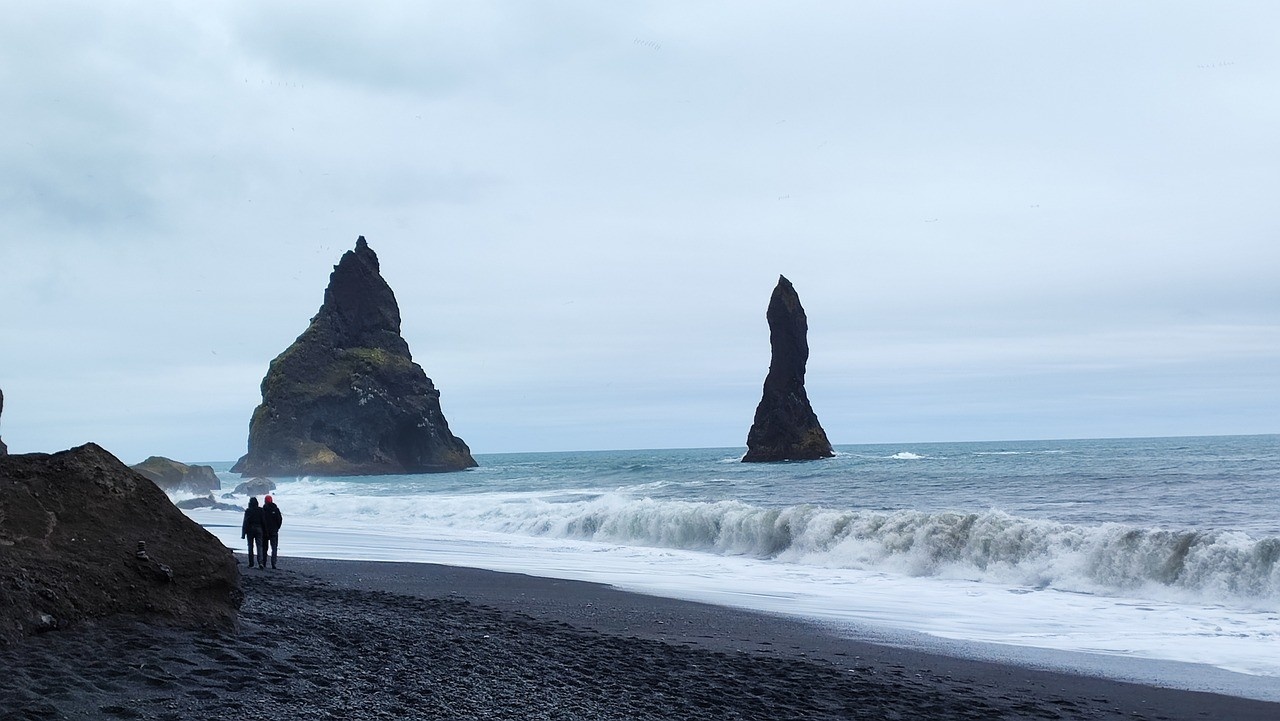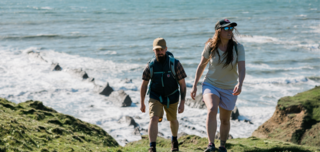Reynisfjara Beach, also known as the Black Sand Beach, is a stunning natural wonder located on the southern coast of Iceland, just a short drive from the picturesque village of Vík í Mýrdal. This breathtaking beach has gained worldwide recognition for its unique and awe-inspiring landscape, characterised by its striking black sand, towering basalt columns, and the majestic Reynisdrangar sea stacks that rise from the Atlantic Ocean. The beach's otherworldly appearance has made it a popular destination for travellers, photographers, and nature enthusiasts alike, drawing visitors from all corners of the globe to witness its raw beauty firsthand. The black sand that covers Reynisfjara Beach is not sand in the traditional sense, but rather small fragments of basalt rock that have been eroded over countless centuries by the powerful waves and harsh weather conditions that batter Iceland's coastline. This distinctive black colouration is a result of the island's extensive volcanic activity, with the basalt rock being formed from cooled lava flows that have solidified over time. The stark contrast between the jet-black sand and the white, foaming waves of the Atlantic Ocean creates a mesmerising visual spectacle that is truly unforgettable.
Geological Formation & Volcanic History
The captivating appearance of Reynisfjara Beach and its surrounding features is intrinsically linked to Iceland's extensive volcanic history and ongoing geological activity. Iceland, situated on the Mid-Atlantic Ridge, is a hotspot for volcanic and geothermal activity due to its unique position straddling the Eurasian and North American tectonic plates. As these plates slowly drift apart, magma from the Earth's mantle rises to the surface, creating the island's numerous volcanoes, lava fields, and distinctive black sand beaches like Reynisfjara. The black sand that defines Reynisfjara Beach is composed of finely ground basalt rock, which is a common volcanic rock type found throughout Iceland. Basalt is formed when lava with a low silica content erupts from a volcano and cools rapidly, resulting in a fine-grained, dark-coloured rock. Over time, the relentless action of the ocean waves and the harsh Icelandic weather conditions break down the basalt into smaller fragments, eventually creating the iconic black sand that covers the beach.
The towering hexagonal basalt columns that flank Reynisfjara Beach are another testament to the island's volcanic past. These striking formations, known as the Garðar, are the result of a process called columnar jointing, which occurs when thick lava flows cool and contract at a slow and steady rate. As the lava cools, it shrinks and cracks into hexagonal shapes, creating distinctive columns that appear to be carved by hand. The size and shape of the columns depend on factors such as the composition of the lava, the rate of cooling, and the thickness of the lava flow. Reynisfjara Beach's basalt columns are believed to have formed during the Tertiary period, approximately 50 to 60 million years ago when the area was subject to extensive volcanic activity. The lava flows that created these columns likely originated from the nearby Katla volcano, one of Iceland's most active and powerful volcanoes. Katla, which lies beneath the Mýrdalsjökull glacier, has erupted numerous times throughout history, with the most recent eruption occurring in 1918. These eruptions have played a significant role in shaping the landscape of southern Iceland, including the formation of Reynisfjara Beach and its surrounding features.
The Reynisdrangar sea stacks, another iconic feature of Reynisfjara Beach, are also the result of Iceland's dynamic geological processes. These towering pillars of rock were once part of the mainland, but over time, the relentless pounding of the ocean waves and the forces of coastal erosion have gradually worn away the surrounding cliffs, leaving only the most resilient sections standing. The sea stacks, composed of sturdy basalt rock, have withstood the test of time and now stand as solitary sentinels, guarding the coast and adding to the beach's mystical atmosphere. Iceland's ongoing volcanic activity continues to shape and reshape the island's landscape, with new lava flows, ash deposits, and geological features constantly being created and modified. This ever-changing nature of Iceland's geology is one of the many reasons why the country remains a top destination for scientists, researchers, and nature enthusiasts from around the world. Reynisfjara Beach, with its striking black sand, hexagonal basalt columns, and imposing sea stacks, serves as a powerful reminder of the Earth's dynamic forces and the breathtaking beauty that can arise from centuries of volcanic activity and coastal erosion.
Folklore and Legends Surrounding Reynisfjara
Reynisfjara Beach is steeped in Icelandic folklore and legends that have been passed down through generations. These captivating tales add an extra layer of intrigue and mystery to the already awe-inspiring landscape. The most prominent legends associated with Reynisfjara revolve around the Reynisdrangar sea stacks and the story of Katla the witch, weaving together elements of mythology, supernatural beings, and the power of nature.
The Legend of the Reynisdrangar Sea Stacks
One of the most captivating legends associated with Reynisfjara Beach revolves around the Reynisdrangar sea stacks, the towering basalt pillars that rise majestically from the Atlantic Ocean just off the shore. According to Icelandic folklore, these sea stacks were once three trolls named Landdrangur, Langsamur, and Skessudrangur. The tale begins with the trolls spotting a ship sailing near the coast and deciding to seize it, wading out into the ocean to drag the vessel back to shore. However, the trolls were so engrossed in their mission that they failed to notice the sun rising on the horizon. As the first rays of daylight touched the trolls, they were instantly transformed into solid stone, forever frozen in their attempt to capture the ship. Today, the Reynisdrangar sea stacks stand as a testament to this legendary tale, their imposing presence serving as a reminder of the mythical creatures that once roamed the Icelandic coastline. This legend not only adds an element of intrigue and mystery to the already awe-inspiring landscape of Reynisfjara Beach but also serves as a cautionary tale about the consequences of greed and the power of nature. The story of the trolls' petrification is deeply rooted in Icelandic mythology, which often portrays these supernatural beings as nocturnal creatures who must avoid exposure to sunlight to survive. The Reynisdrangar sea stacks have become an integral part of the beach's identity, drawing visitors from around the world who are eager to witness these majestic formations and learn about the rich folklore that surrounds them.
The Tale of Katla the Witch
Another fascinating legend tied to Reynisfjara Beach is that of Katla, a powerful witch believed to have lived in a cave near the shoreline. According to local lore, Katla possessed the ability to control the weather and the ocean, making her both revered and feared by the inhabitants of the nearby village. Fishermen and sailors would often seek Katla's favour before setting out to sea, offering gifts and prayers in exchange for safe passage and bountiful catches. However, those who disrespected or angered the witch were said to face her wrath, with fierce storms and treacherous waves unleashed upon them as punishment. The legend of Katla the witch is thought to be connected to the nearby Katla volcano, one of Iceland's most active and powerful volcanic systems. The volcano, which lies partially concealed beneath the Mýrdalsjökull glacier, shares its name with the legendary witch and is believed to be her final resting place. Some versions of the tale suggest that Katla's spirit still resides within the volcano and that her anger and frustration manifest in the form of volcanic eruptions and glacial floods known as jökulhlaups. This intertwining of folklore and geological activity adds an extra layer of intrigue to the area surrounding Reynisfjara Beach, inviting visitors to ponder the relationship between myth and the natural world. The tales of the Reynisdrangar sea stacks and Katla the witch are just two examples of the rich tapestry of folklore that envelops Reynisfjara Beach and its environs. These legends passed down through generations, contribute to the mystical atmosphere that permeates the landscape, enhancing the sense of wonder and enchantment experienced by those who visit. By engaging with these stories and immersing themselves in the mythological heritage of the region, visitors can gain a deeper appreciation for the cultural significance of Reynisfjara Beach and the enduring power of storytelling in shaping Iceland's identity.
Reynisfjara Beach in Pop Culture
The otherworldly beauty and fantastical appearance of Reynisfjara Beach have made it a sought-after destination for filmmakers and television producers from around the globe. The beach's striking black sand, towering basalt columns, and majestic sea stacks have served as the perfect backdrop for numerous movies and TV shows, transporting audiences to distant planets, mythical realms, and post-apocalyptic worlds. From the hit series Game of Thrones to Hollywood blockbusters like Star Wars and Noah, Reynisfjara has left an indelible mark on popular culture.
A Captivating Backdrop for Film and Television
Reynisfjara Beach, with its otherworldly beauty and fantastical appearance, has become a sought-after destination for filmmakers and television producers from around the globe. The beach's striking black sand, towering basalt columns, and majestic sea stacks create a unique landscape that has served as the perfect backdrop for numerous movies and TV shows, transporting audiences to distant planets, mythical realms, and post-apocalyptic worlds. The stark contrasts and eerie atmosphere of Reynisfjara have proven to be an invaluable asset for storytellers, allowing them to craft immersive and compelling narratives that captivate and inspire audiences.
One of the most notable appearances of Reynisfjara Beach in popular culture is its role in the hit HBO series, Game of Thrones. The show's creators were drawn to the beach's haunting beauty and foreboding atmosphere, which perfectly captured the sense of isolation and danger that characterises the world of Westeros. In the series, Reynisfjara served as the location of Eastwatch-by-the-Sea, a castle manned by the Night's Watch that guards the eastern end of the Wall. The beach's black sand and looming cliffs provided a stunning and memorable setting for some of the show's most pivotal scenes, including the arrival of Jon Snow and his companions at the Wall and the dramatic confrontation between the Night's Watch and the Wildlings. The success of Game of Thrones has only served to increase Reynisfjara Beach's popularity among filmmakers and television producers, who have been eager to capitalise on the beach's unique visual appeal and storytelling potential. In recent years, the beach has been featured in a wide range of productions, from big-budget Hollywood blockbusters to independent art films and documentaries. Each of these projects has brought its unique perspective and creative vision to the beach, showcasing the incredible versatility and adaptability of this natural wonder.
From a Galaxy Far, Far Away to the Final Frontier
Reynisfjara Beach's popularity among filmmakers and television producers is not limited to the realm of fantasy and historical drama. The beach has also made its mark on the world of science fiction, appearing in several blockbuster movies that have transported audiences to distant galaxies and uncharted corners of the universe. The beach's rugged terrain, otherworldly appearance, and stark, alien beauty have made it the perfect choice for depicting the strange and wondrous worlds that lie beyond our own. In Rogue One: A Star Wars Story, Reynisfjara Beach served as the backdrop for the planet Eadu, a remote and inhospitable world that housed a secret Imperial research facility. The film's visual effects team seamlessly blended footage of the beach with computer-generated imagery to create a convincing and immersive alien landscape, complete with towering cliffs, raging storms, and eerie, unearthly light. The beach's black sand and jagged rock formations added to the sense of danger and isolation that permeated the scenes set on Eadu, underscoring the high stakes and desperate struggles of the film's characters.
Similarly, in Star Trek: Into Darkness, Reynisfjara Beach was used to represent a primitive, uninhabited planet that the crew of the USS Enterprise visits during their mission. The beach's stark, monochromatic landscape and otherworldly rock formations made it the perfect choice for depicting an alien world, showcasing the incredible diversity and wonder of the Star Trek universe. The film's use of Reynisfjara Beach was a testament to the enduring appeal of science fiction storytelling and to the power of iconic locations to transport audiences to new and exciting worlds. The beach's unique visual qualities and otherworldly atmosphere make it an ideal canvas for the imagination, allowing storytellers to craft compelling and unforgettable tales of adventure, discovery, and wonder. Whether used as a backdrop for epic space battles, thrilling planetary explorations, or quiet moments of contemplation and reflection, Reynisfjara Beach is sure to continue captivating audiences and inspiring new generations of science fiction storytellers for years to come.
A Testament to the Raw Power of Nature
Beyond the realms of fantasy and science fiction, Reynisfjara Beach has also been featured in more grounded, dramatic productions that seek to explore the raw power and majesty of the natural world. The beach's thundering waves, brooding skies, and stark, monochromatic landscape have made it a powerful visual metaphor for the primal forces that shape our planet and the resilience of the human spirit in the face of adversity. In the biblical epic Noah, directed by Darren Aronofsky, Reynisfjara Beach served as a key location for some of the film's most powerful and memorable scenes. The beach's black sand and towering cliffs provide a haunting and apocalyptic backdrop for the story of Noah and his family, who must navigate the challenges and dangers of a world consumed by sin and destruction. The film's climactic sequences, which depict the great flood that engulfs the earth, were shot on location at Reynisfjara, with the beach's raging seas and tempestuous skies adding to the sense of chaos and devastation. Aronofsky's use of Reynisfjara Beach in Noah was a testament to the enduring power of nature as a source of both terror and wonder and to the ability of great filmmaking to capture and convey the awesome majesty of the natural world. The beach's stark, elemental beauty and raw, untamed energy made it the perfect setting for a story that grapples with the deepest questions of faith, morality, and the human condition, and its impact on the film's visual language and emotional resonance cannot be overstated.
A Magnet for Photographers and Artists
In addition to its popularity among filmmakers and television producers, Reynisfjara Beach has also become a mecca for photographers and artists from around the world, drawn to its stark beauty, otherworldly atmosphere, and endless opportunities for creative expression and visual experimentation. The beach's unique combination of black sand, towering basalt columns, and majestic sea stacks creates a landscape that is at once timeless and ever-changing, offering endless possibilities for those seeking to capture its essence and share its wonders with the world.
For photographers, Reynisfjara Beach is a true paradise, with its stark contrasts, dramatic lines, and textures providing endless opportunities for stunning and unforgettable images. Many photographers are drawn to the beach's basalt columns, which create a hypnotic pattern of hexagonal shapes that seem to defy the laws of nature. These columns, formed by the slow cooling and contraction of ancient lava flows, are a testament to the incredible geological forces that have shaped Iceland's landscape over millions of years, and their intricate beauty and symmetry never fail to captivate and inspire. Other photographers focus their lenses on the Reynisdrangar sea stacks, which rise majestically from the churning waters of the Atlantic like ancient sentinels guarding the coast. These towering pillars of rock, sculpted by the relentless pounding of the waves and the harsh Icelandic winds, are a powerful symbol of the raw, untamed energy of the natural world, and their craggy, weather-beaten surfaces and dramatic silhouettes make them an irresistible subject for photographers seeking to capture the essence of Iceland's rugged beauty.
For landscape painters and sketch artists, Reynisfjara Beach is a never-ending source of inspiration, with its sweeping vistas, brooding skies, and constantly shifting light and shadow. The beach's monochromatic palette of black, white, and grey creates a sense of timelessness and mystery, inviting artists to explore the deeper emotional and spiritual resonances of the landscape and to capture its essence in their unique way. Whether working en plein air or from photographs and sketches, artists who visit Reynisfjara Beach find themselves drawn into a world of incredible beauty and raw, elemental power, one that challenges and inspires them to push the boundaries of their creativity and to find new ways of seeing and expressing the world around them. Through their work, the beach will continue to inspire and captivate audiences, cementing its place as one of the most iconic and beloved natural wonders of Iceland and the world. Whether captured in stunning photographs, evocative paintings, or intricate sketches, the magic and mystery of Reynisfjara Beach will endure, inviting us all to marvel at the incredible beauty and power of the natural world and to find our way of connecting with its timeless and eternal spirit.
Nearby Attractions
Vík í Mýrdal
Vík í Mýrdal, a picturesque village situated along Iceland's southern coast, is a destination that captivates visitors with its stunning natural beauty, rich history, and warm, welcoming community. This charming settlement serves as the perfect base for exploring the region's many wonders, offering a wide range of activities and attractions that cater to every interest and taste. At the heart of Vík stands the iconic Víkurkirkja, a beautiful hilltop church whose striking white exterior and vibrant red roof create a breathtaking contrast against the backdrop of the surrounding cliffs and sea stacks. The church's unique architecture and panoramic views make it a popular spot for photography enthusiasts, as well as those seeking a moment of tranquillity and reflection amidst the grandeur of the Icelandic landscape. Visitors to Vík will find themselves enchanted by the village's quaint streets, lined with colourful houses and friendly locals eager to share their stories and traditions. The town's shops and galleries offer a delightful array of handcrafted goods, unique souvenirs, and locally-produced art, providing the perfect opportunity to bring home a piece of authentic Icelandic culture. For those looking to indulge in the flavours of the region, Vík's restaurants and cafes serve up a mouth-watering selection of traditional Icelandic dishes, featuring fresh, locally sourced ingredients such as succulent lamb, freshly caught seafood, and an array of seasonal vegetables. From cosy, intimate bistros to lively pubs and cafes, there's a dining experience to suit every taste and occasion.
One of the greatest advantages of staying in Vík is its proximity to some of Iceland's most awe-inspiring natural attractions. The village serves as the perfect jumping-off point for exploring the nearby black sand beaches, majestic glaciers, and thundering waterfalls that have made this region famous around the world. Many guided tours and excursions depart from Vík, offering visitors the chance to discover these wonders in the company of knowledgeable local guides who can provide insights into the area's geology, history, and ecology. For those who prefer a more independent exploration of the region, Vík's well-equipped campground offers a convenient and affordable option, with stunning views of the surrounding landscape and easy access to hiking trails and other outdoor activities. Beyond its natural beauty and outdoor adventures, Vík is also a community that values its rich cultural heritage and traditions. Visitors can discover more about the village's history by visiting the Skaftfellingur Museum, which showcases exhibits on the region's geology, flora and fauna, and the lives of the early settlers who made their home along this rugged coastline. The museum also features a fascinating section dedicated to the 1918 eruption of the nearby Katla volcano, which had a profound impact on the region and its inhabitants, shaping the landscape and the lives of those who call this place home.
Dyrhólaey Promontory
The Dyrhólaey promontory, a breathtaking natural wonder located just a short drive west of Reynisfjara Beach, is an awe-inspiring destination that showcases the raw power and untamed beauty of Iceland's coastline. Rising an impressive 120 meters (394 feet) above the crashing waves of the Atlantic Ocean, this massive sea cliff offers visitors the chance to witness the majesty of nature on a truly epic scale. One of Dyrhólaey's most striking features is the colossal rock arch that extends out from the cliffside, creating a natural bridge over the churning waters below. This geological marvel is a testament to the ceaseless forces of erosion that have shaped Iceland's landscape over countless millennia, carving out a scene of unparalleled grandeur and beauty that takes one's breath away.
From this lofty vantage point, one can take in the sight of the imposing Reynisdrangar sea stacks rising majestically from the ocean, the distant peaks of the Mýrdalsjökull glacier glinting in the sun, and the seemingly infinite expanse of the Atlantic stretching out to the horizon in an unbroken blue. The promontory is also home to a rich and diverse array of seabirds, including the charming and colourful puffins that can be seen nesting on the rocky ledges during the summer months. Birdwatchers and nature enthusiasts will be in their element here, with the opportunity to observe these delightful creatures up close in their natural habitat. Another highlight of visiting Dyrhólaey is the chance to explore the old lighthouse that stands proudly atop the promontory, a silent sentinel that has been guiding ships and sailors safely along the coast for generations. Built-in the early 20th century, this historic structure is a fascinating window into Iceland's rich maritime heritage, offering visitors the opportunity to learn about the vital role it has played in ensuring the safety and prosperity of the region's coastal communities.
Sólheimajökull Glacier
Sólheimajökull glacier, a magnificent ice cap located approximately 30 kilometres (19 miles) northwest of Reynisfjara Beach, is a true wonder of the natural world and an adventure-seeker's paradise. This sprawling glacier offers visitors the chance to immerse themselves in the landscape of deep crevasses, towering ice formations, and shimmering blue meltwater streams, all while experiencing the raw power and beauty of Iceland's frozen wilderness. Joining a guided tour led by experienced and knowledgeable guides is the perfect way to explore this otherworldly terrain, as they provide the necessary equipment and expertise to ensure a safe and unforgettable journey across the glacier's surface. With tours catering to a range of skill levels, from beginner-friendly walks to more challenging ice climbing excursions, there's an adventure to suit every visitor's interests and abilities. One of the most compelling reasons to visit Sólheimajökull is the opportunity to witness firsthand the profound impact of climate change on our planet's delicate ecosystems. As global temperatures continue to rise at an alarming rate, the glacier has been rapidly retreating, serving as a poignant reminder of the urgent need to take action to protect and preserve these incredible natural wonders for generations to come. By setting foot on this majestic ice cap and seeing the effects of climate change up close, visitors can gain a deeper understanding and appreciation of the fragility of our environment and the importance of making sustainable choices in our daily lives.
In addition to the thrill of exploring the glacier itself, a visit to Sólheimajökull also offers a unique opportunity to learn about the fascinating geological processes that have shaped Iceland's distinctive landscape over millions of years. The passionate and knowledgeable guides who lead the tours are eager to share their expertise with visitors, providing captivating insights into the formation of glaciers, the impact of volcanic activity on the region, and the delicate balance of the local ecosystem. This educational aspect of the experience adds a rich layer of depth and meaning to the adventure, allowing visitors to come away with a greater understanding and appreciation of the natural world and the complex forces that have moulded it into the wonder we see today. Beyond the glacier itself, the surrounding landscape of Sólheimajökull is a treasure trove of natural beauty and wonder, with stunning vistas of snow-capped mountains, lush green valleys, and crystal-clear streams and rivers.
Related articles

Let us know you agree to cookies
We use marketing, analytical and functional cookies as well as similar technologies to give you the best experience. Third parties, including social media platforms, often place tracking cookies on our site to show you personalised adverts outside of our website.
We store your cookie preferences for two years and you can edit your preferences via ‘manage cookies’ or through the cookie policy at the bottom of every page. For more information, please see our cookie policy.
